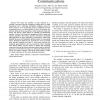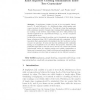307 search results - page 45 / 62 » A Comparison of Algorithms for Connected Set Openings and Cl... |
TNN
2010
13 years 2 months ago
2010
Soft computing (SC) emerged as an integrating framework for a number of techniques that could complement one another quite well (artificial neural networks, fuzzy systems, evolutio...
AGILE
2009
Springer
14 years 2 months ago
2009
Springer
We study a point pattern detection problem on networks, motivated by geographical analysis tasks, such as crime hotspot detection. Given a network N (for example, a street, train,...
CISS
2008
IEEE
14 years 1 months ago
2008
IEEE
— We study the problem of relay selection in a wireless cooperative network. Assuming a single source, a single destination, and N uniformly distributed candidate relays, we seek...
WEA
2010
Springer
14 years 2 months ago
2010
Springer
A tanglegram consists of a pair of (not necessarily binary) trees T1, T2 with leaf sets L1, L2. Additional edges, called tangles, may connect nodes in L1 with those in L2. The task...
ALENEX
2009
13 years 8 months ago
2009
A tanglegram is a pair of trees whose leaf sets are in oneto-one correspondence; matching leaves are connected by inter-tree edges. In applications such as phylogenetics or hierar...


